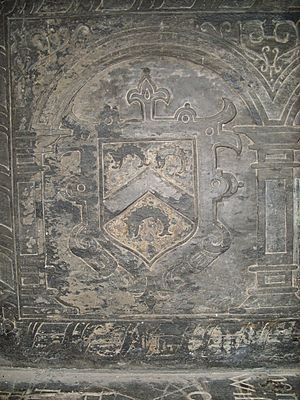Edward Nicholas Kendall facts for kids
Quick facts for kids
Edward Nicholas Kendall
|
|
|---|---|
| Born | October 1800 probably England |
| Died | 12 February 1845 Southampton, England |
| Allegiance | |
| Service/ |
Royal Navy |
| Years of service | 1831–1841 |
| Rank | Lieutenant |
Edward Nicholas Kendall (October 1800 – 12 February 1845) was an English explorer and mapmaker. He was an officer in the Royal Navy, which is the United Kingdom's navy. Kendall was known for his work in hydrography, which is the science of mapping water areas like oceans and rivers. He also explored the Arctic and was the first known European to see Wollaston Peninsula.
Contents
Early Life and Education
Edward Nicholas Kendall was born in 1800, likely in England. His father, also named Edward Kendall, was a naval captain. The Kendall family came from Cornwall, a county in southwest England.
Edward had three younger siblings: William, Mary, and Amelia. He went to the Royal Naval College in Portsmouth. After finishing his studies, he joined the Royal Navy in 1814.
A Career of Exploration and Mapping
Kendall started his naval career as a midshipman, a junior officer, on a ship called HMS Mutine. Later, while serving on HMS Erne, his ship was wrecked in 1819 near Sal, Cape Verde, and he was injured.
He served on other ships, often working as a surveyor. A surveyor measures and maps land or water. He helped map areas like Orkney, Shetland, the coast of Ireland, and parts of the North Sea.
Arctic Adventures
In 1824, Kendall volunteered for an important expedition. He joined William Edward Parry's third journey to find the Northwest Passage. This was a sea route connecting the Atlantic and Pacific oceans through the Arctic. Kendall worked as an assistant surveyor on HMS Griper.
From 1825 to 1827, Kendall joined another famous explorer, John Franklin, on the Mackenzie River expedition. He helped explore the Mackenzie River Delta in Canada. During this trip, he became the first known European to see Wollaston Peninsula. He also traveled a long distance from Fort Franklin to York Factory. In 1827, he was promoted to lieutenant.
Scientific Voyages and Border Surveys
The next year, Kendall sailed on HMS Chanticleer for a scientific trip. He helped with experiments, including using pendulums to study gravity. He also mapped parts of the South Shetland Islands in the Antarctic.
In 1830, he moved to HMS Hecla to map the coast of West Africa. He returned to England later that year. He then worked for the British government on a secret project. He helped map the border between British and American lands in New Brunswick, Canada. He finished a map of New Brunswick in 1831. Even though he was highly recommended, Kendall remained a lieutenant.
Later Life
Around 1833, Kendall became involved with the New Brunswick and Nova Scotia Land Company. He worked as a commissioner in Fredericton. He returned to Britain by 1838. In his later years, he managed steamship companies, first the West India Mail Steam Navigation Company and then the Peninsular and Oriental Steam Packet Company in Southampton.
Family Life
Edward Kendall had four children from an earlier relationship: Edward Kay Kendall, Franklin Richardson Kendall, Robert Sinclair Kendall, and Mary Anne Kendall. His family tree includes famous people like Canadian musician Simon Kendall and basketball player Levon Kendall.
In 1832, he married Mary Anne Kay. She was the daughter of Joseph Kay, a London architect. Mary Anne's mother was Sarah Henrietta Porden, who was the sister of Eleanor Anne Porden, John Franklin's first wife.
Kendall passed away in 1845 in Southampton, England. He was buried at Carisbrooke on the Isle of Wight. His personal papers are kept in the archives of the Royal Geographical Society in London.
Legacy
Several places were named after Edward Kendall to honor his explorations:
- Kendall Island in the Mackenzie Delta.
- Cape Kendall, which can be seen from the Coppermine River.
- Kendall Rocks, a group of rocks in the Palmer Archipelago in Antarctica.
Selected Works
- (1842). Remarks on steam communication between England and Australasia: As combined with a system of weekly communication between the colonies of Australasia.
See also


